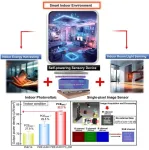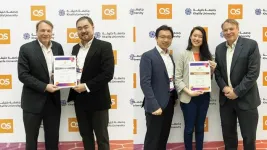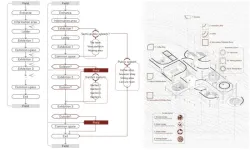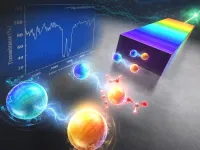(Press-News.org) Organic-based optoelectronic technology is increasingly recognized as an energy-efficient solution for low-power indoor electronics and wireless IoT sensors. This is largely due to its superior flexibility and light weight compared to conventional silicon-based devices. Notably, organic photovoltaic cells (OPVs) and organic photodetectors (OPDs) are leading examples in this field. OPVs have the remarkable ability to absorb energy and generate electricity even under very low light condition, while OPDs are capable of capturing images. However, despite their potential, the development of these devices has been conducted independently thus far. As a result, they have not yet reached the level of efficiency necessary to be considered practical for next-generation, miniaturized devices.
The Korea Institute of Science and Technology (KIST), led by Dr. Min-Chul Park and Dr. Do Kyung Hwang of the Center for Opto-Electronic Materials and Devices, Prof. Jae Won Shim and Prof. Tae Geun Kim of the School of Electrical Engineering at Korea University, Prof. JaeHong Park of the Department of Chemistry and Nanoscience at Ewha Womans University, have developed an organic-based optoelcectronic device. This innovative device not only integrates the functionalities of organic photovoltaic cells (OPVs) and organic photodetectors (OPDs) but also pioneers in visualizing images in applications requiring low-light conditions, thereby enhancing energy efficiency in indoor environments.
By advancing the organic semiconductor layer into a multicomponent structure, the research team has enhanced the device's performance. In door environments, it achieves an impressive photoelectric conversion efficiency exceeding 32%, along with a linear dynamic range surpassing 130 dB. This significant improvement in contrast ratio, especially in low-light conditions, allows for a much clearer image than conventional silicon devices, which typically offer a linear dynamic range of 100 dB.
The collaborative research team made further strides by successfully applying single-pixel image sensing. This image sensing system capture ambient light, transforms into electrical energy, and utilize this energy to acquire images. In contrast to the previous need for specialized cameras in low-light of standard lighting conditions, the newly developed photodetector, featuring a multi-component semiconductor layer, offers a versatile application. It can function not only as a conventional camera but also as a decorative element on windows or walls, providing sufficient resolution to discern shapes and movements of objects.
Dr. Min-chul Park from KIST highlighted the versatility of this technology, noting, "While primarily functioning as an energy harvester, it can also be applied to detect movement and recognize motion patterns in environments without light." He further expressed optimism about its potential applications, stating, "This holds great promise not only for human-computer interaction (HCI) research but also in various industrial sectors, including smart indoor environments."
###
KIST was established in 1966 as the first government-funded research institute in Korea. KIST now strives to solve national and social challenges and secure growth engines through leading and innovative research. For more information, please visit KIST’s website at https://eng.kist.re.kr/
This research was supported by the Ministry of Science and ICT (Minister Lee Jong-ho) as a KIST Institutional Program, a mid-career research support project of the Korea Research Foundation, and a Leader Research Project, and the results have been published in the international journal Advanced Materials (IF: 29.4, JCR(%): 2.312) and published online on November 2023.
Organic-based optoelectronic technology is increasingly recognized as an energy-efficient solution for low-power indoor electronics and wireless IoT sensors. This is largely due to its superior flexibility and light weight compared to conventional silicon-based devices. Notably, organic photovoltaic cells (OPVs) and organic photodetectors (OPDs) are leading examples in this field. OPVs have the remarkable ability to absorb energy and generate electricity even under very low light condition, while OPDs are capable of capturing images. However, despite their potential, the development of these devices has been conducted independently thus far. As a result, they have not yet reached the level of efficiency necessary to be considered practical for next-generation, miniaturized devices.
The Korea Institute of Science and Technology (KIST), led by Dr. Min-Chul Park and Dr. Do Kyung Hwang of the Center for Opto-Electronic Materials and Devices, Prof. Jae Won Shim and Prof. Tae Geun Kim of the School of Electrical Engineering at Korea University, Prof. JaeHong Park of the Department of Chemistry and Nanoscience at Ewha Womans University, have developed an organic-based optoelcectronic device. This innovative device not only integrates the functionalities of organic photovoltaic cells (OPVs) and organic photodetectors (OPDs) but also pioneers in visualizing images in applications requiring low-light conditions, thereby enhancing energy efficiency in indoor environments.
By advancing the organic semiconductor layer into a multicomponent structure, the research team has enhanced the device's performance. In door environments, it achieves an impressive photoelectric conversion efficiency exceeding 32%, along with a linear dynamic range surpassing 130 dB. This significant improvement in contrast ratio, especially in low-light conditions, allows for a much clearer image than conventional silicon devices, which typically offer a linear dynamic range of 100 dB.
The collaborative research team made further strides by successfully applying single-pixel image sensing. This image sensing system capture ambient light, transforms into electrical energy, and utilize this energy to acquire images. In contrast to the previous need for specialized cameras in low-light of standard lighting conditions, the newly developed photodetector, featuring a multi-component semiconductor layer, offers a versatile application. It can function not only as a conventional camera but also as a decorative element on windows or walls, providing sufficient resolution to discern shapes and movements of objects.
Dr. Min-chul Park from KIST highlighted the versatility of this technology, noting, "While primarily functioning as an energy harvester, it can also be applied to detect movement and recognize motion patterns in environments without light." He further expressed optimism about its potential applications, stating, "This holds great promise not only for human-computer interaction (HCI) research but also in various industrial sectors, including smart indoor environments."
###
KIST was established in 1966 as the first government-funded research institute in Korea. KIST now strives to solve national and social challenges and secure growth engines through leading and innovative research. For more information, please visit KIST’s website at https://eng.kist.re.kr/
This research was supported by the Ministry of Science and ICT (Minister Lee Jong-ho) as a KIST Institutional Program, a mid-career research support project of the Korea Research Foundation, and a Leader Research Project, and the results have been published in the international journal Advanced Materials (IF: 29.4, JCR(%): 2.312) and published online on November 2023.
END
Advanced Full-color image sensor technology enabling simultaneous energy harvesting and imaging
Single-pixel imaging successfully achieved for the first time using an organic-based photoelectric photodetector.
2024-01-25
ELSE PRESS RELEASES FROM THIS DATE:
New analysis shows that disinfection is the most effective way to prevent viral contamination of restroom surfaces
2024-01-25
Arlington, Va. — January 25, 2024 — A new study published today in the American Journal of Infection Control (AJIC) demonstrates that viral particles spread to many restroom surfaces during toilet flushing, regardless of whether the toilet lid is up or down. In this analysis, the only meaningful way of reducing viral particles was through disinfection of the toilet, toilet water, and nearby surfaces.
Scientists have long known that the process of toilet flushing can aerosolize pathogens expelled into the toilet bowl by an unhealthy individual. The aerosol plume created from the force of flushing can ...
Diverse forests are best at standing up to storms
2024-01-25
European forests with a greater diversity of tree species are more resilient to storms, according to new research published in the British Ecological Society journal, Functional Ecology.
A new study by researchers at the French National Research Institute for Agriculture, Food and Environment (INRAE) reveals that in Europe, the forests that are most resilient to storms are those with a greater diversity of tree species and dominated by slow growing species with high wood density, like oaks.
The researchers also found that the positive effect of ...
More reporting needed to show progress on Ontario municipal climate and sustainability plans
2024-01-25
While sustainability reporting is a widespread practice in the private sector, new research shows that the same cannot be said for Ontario municipalities.
Researchers at the University of Waterloo studied 38 municipalities in Ontario, representing more than two-thirds of the population, and discovered that almost all municipalities publish their sustainability and climate change goals, but under half are formally reporting on their progress.
Municipalities are a key part of the equation ...
Recovering lossless propagation: HKU physicists overcoming optical loss in polariton system with synthetic complex frequency waves
2024-01-25
A collaborative research team co-led by Professor Shuang ZHANG, the Interim Head of the Department of Physics, The University of Hong Kong (HKU), along with Professor Qing DAI from National Center for Nanoscience and Technology, China, has introduced a solution to a prevalent issue in the realm of nanophotonics – the study of light at an extremely small scale. Their findings, recently published in the prestigious academic journal Nature Materials, propose a synthetic complex frequency wave (CFW) approach to address optical loss in polariton propagation. These findings offer practical solutions such as more efficient light-based devices for faster and ...
HKU Common Core and HKUMed teams win one Silver and one Bronze in QS Reimagine Education Awards
2024-01-25
Two innovative teaching and learning projects led by The University of Hong Kong (HKU) earned honours in the Quacquarelli Symonds (QS) Reimagine Education Awards, presented in Abu Dhabi in December 2023.
Often referred to as the "Oscars of Education," the awards are designed to honour the most innovative and effective approaches to enhancing student learning experiences and employability outcomes.
The 2023 QS Reimagine Education Awards received a record number of more than 1,200 submissions across 17 categories. HKU has garnered ...
A pathway to environmental restoration: Sustainable strategies for cesium removal from radioactive wastewater
2024-01-25
The Fukushima Daiichi nuclear disaster, triggered by the earthquake and tsunami on March 11, 2011, resulted in a severe release of radioactive materials, including cesium, from the damaged nuclear reactors. The loss of cooling capabilities led to partial meltdowns in the reactor cores, releasing a substantial amount of cesium-137 (Cs-137) and cesium-134 (Cs-134) into the environment. The release of Cs-137, in particular, poses environmental and human health hazards due to its long half-life and high mobility in the environment. Environmentally, Cs-137 contributes ...
A building rising from the hilltop—Three topographical approaches to building in a landscape
2024-01-25
This essay writes on a building project in the remote southwestern China that is built in uninhabited and is inspired and informed by its landscape context. The essay discusses how an extraordinary building project reacts to three different dimensions about landscape–architecture—a natural terrain being manipulated and recast. A small building needs to find its precise connecting point to a much larger historical and environmental context. A practical project needs to reach a balance between architectural pursuits and engineering concerns. Initially, artificial works might be isolated from and in conflict with the terrain, which requires architectural approaches ...
Avoiding cloudy messaging: Vape prevention campaigns face challenges
2024-01-25
Flinders University researchers say that cohesive and collaborative action from preventive health communicators and organisations is needed to inform young people about the devastating harms of vaping.
“Despite awareness of the potential harms, recreational vaping is increasing among younger people with our South Australian participants seeing vaping as ‘cleaner’ and less harmful than cigarettes,” says Flinders University’s Dr Joshua Trigg.
“We know that nicotine vapes are highly addictive and expose people to harmful chemicals, respiratory irritants, and toxic substances. In order to discourage ...
Lights, detector, action!
2024-01-25
Kyoto, Japan -- Our understanding of the world relies greatly on our knowledge of its constituent materials and their interactions. Recent advances in materials science technologies have ratcheted up our ability to identify chemical substances and expanded possible applications.
One such technology is infrared spectroscopy, used for molecular identification in various fields, such as in medicine, environmental monitoring, and industrial production. However, even the best existing tool -- the Fourier transform infrared spectrometer or FTIR -- utilizes a heating element as its light source. Resulting detector noise in the infrared region limits the devices' ...
It’s time to address the high rate of Australians with disabilities addicted to smoking
2024-01-25
According to a new analysis, almost a quarter of Australians with disabilities smoke when compared to just 12.6% of the wider population.
While the number of Australians smoking is declining, the barriers for people with disabilities mean targeted support is needed to develop healthier habits.
Flinders University and Cancer Council NSW health experts are recommending new strategies to tackle the alarming smoking rate through targeted government policies, data collection on smoking and training for disability support workers on tobacco prevention ...
LAST 30 PRESS RELEASES:
University of Phoenix College of Doctoral Studies releases white paper on AI-driven skilling to reduce burnout and restore worker autonomy
AIs fail at the game of visual “telephone”
The levers for a sustainable food system
Potential changes in US homelessness by ending federal support for housing first programs
Vulnerability of large language models to prompt injection when providing medical advice
Researchers develop new system for high-energy-density, long-life, multi-electron transfer bromine-based flow batteries
Ending federal support for housing first programs could increase U.S. homelessness by 5% in one year, new JAMA study finds
New research uncovers molecular ‘safety switch’ shielding cancers from immune attack
Bacteria resisting viral infection can still sink carbon to ocean floor
Younger biological age may increase depression risk in older women during COVID-19
Bharat Innovates 2026 National Basecamp Showcases India’s Most Promising Deep-Tech Ventures
Here’s what determines whether your income level rises or falls
SCIE indexation achievement: Celebrate with Space: Science & Technology
Children’s Hospital Colorado performs region’s first pediatric heart and liver dual organ transplant
Australian team discover why quantum computers have memory problems over time
What determines the fate of a T cell?
Candida auris: genetic process revealed which could be treatment target for deadly fungal disease
Groundbreaking discovery turns household plastic recycling into anti-cancer medication
Blocking a key inflammatory pathway improves liver structure and vascular function in cirrhosis, study finds
Continuous spread: Raccoon roundworm detected in nine European countries
HKUST Engineering researchers developed a novel photodetector to enhance the performance of on-chip light monitoring
Strategic river sensors could have forewarned of Texas Camp flood disaster
Drone sampling of whale breath reveals first evidence of potentially deadly virus in Arctic
Roman soldiers defending Hadrian’s Wall infected by parasites, study finds
Pinochet’s prisoners were tormented with music but still found solace in it, a new book reveals
Fertility remains high in rural Tanzania despite access to family planning
AI-assisted device can improve autism care access
Kinetic careers
Uncovering how parasitic plants avoid attacking themselves to improve crop resistance
Nanoparticle vaccine strategy could protect against Ebola and other deadly filoviruses
[Press-News.org] Advanced Full-color image sensor technology enabling simultaneous energy harvesting and imagingSingle-pixel imaging successfully achieved for the first time using an organic-based photoelectric photodetector.









